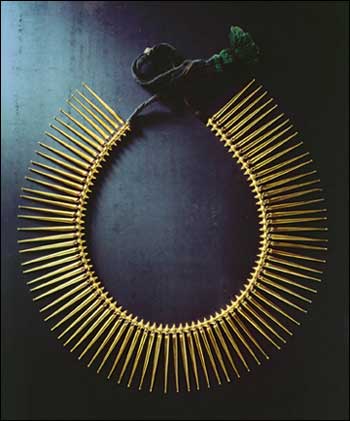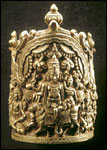
Necklace with Jasmine buds Jadi Pu Malai ou Mullai Arumbu Malai. Gold and ruby.
South India, Tamil Nadu, xixe-xxe century. Crédit: Studio Ferrazzini Bouchet Photographies |
|
Ensemble Conventuel des Jacobins
CONSERVATION
69, rue Pargaminières
31000 Toulouse - France
INFORMATION :
Tel. 05 61 22 21 92
website: www.jacobins.mairie-toulouse.fr
e-mail: jacobins@mairie-toulouse.fr
HOURS:
Open everyday including holidays
from 10am to 7pm
Entrance through the church, rue Lakanal.
PRICES OF ADMISSION:
Normal price: 5 €
Concessions and groups: 2,50 €
CURATOR:
Monique REY-DELQUÉ
Conservateur du Patrimoine
Directeur de l'Ensemble Conventuel des Jacobins
et Chargée du Patrimoine Historique de la Ville de Toulouse
PRESS CONTACT:
Agence KOM
Suzanne Manheimer
29, rue Valade
31000 Toulouse - France
Tel. 05 34 416 412 Fax: 05 34 416 413
e-mail: agencekom@agencekom.com

|
The Indian jewels from the Barbier-Mueller collection are mostly from Southern India, a region of great wealth in the ancient times, with its gold, diamonds, beryls, rubies and precious stones from the famous mines of Golconde. The Ensemble Conventuel des Jacobins in Toulouse is the first in France to reveal its entirety. Bracelets from Tamil Nadu, pendants from Coorg, earrings from Kerala, necklaces from Rajasthan, gold, silver and coral, decorated with sumptuous rubies, emeralds and greatly refined diamonds make up this treasure of the XIXth century and beginning of the XXth.
Gold and the sacred
In India, jewels were one’s personal fortune and indicated the owner’s social position, their belonging to a cast, a community or a religion. Sovereigns on their part used precious stones and jewels to affirm power and prestige. To the Indian woman, jewels represented a financial guarantee - stridhan - that was offered to her upon her marriage and that she could exchange in case she was in need. In this civilisation where art expresses what is sacred, jewels were not only decorative objects: they were also amulets. The belief according to which gold and precious stones have healing virtues and can ward off ill fortune was deeply rooted in the Indian soul. One showed off one’s gems and ornaments to defend oneself against evil and exploit the good influence of the planets.
Illustration : Crown or bracelet Mukuta. Gold and rubies.. South India Tamil Nadu, 19th century
Photo : Studio Ferrazzini Bouchet Photographies
A tradition deeply rooted in the Indian soul
The Barbier-Mueller jewels have lines and shapes where complexity, refinement and magnificence combine to reveal the Indian jeweler’s aesthetic sensitivity as well as the high competence of his technique. In the ancient Indian texts, the Veda, it is said that by wearing gold as an offering, one is granted material security and eternal life. From time immemorial, the Indians have considered gold as an indestructible metal, with multiple qualities and which is not only used for making jewels... All that is used to make the jewels, the metal, the drawing, the decoration as well as the stones, combine to invent a language rich in symbols whose origins go back to ancient spiritual beliefs. By their pure beauty or their magnificence, the works shown in this exhibit are sufficient proof of this tradition strongly rooted in the Indian soul and its evolution over various thousands of years.
|









